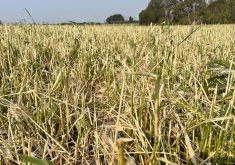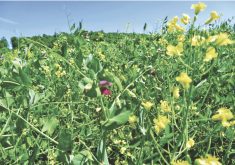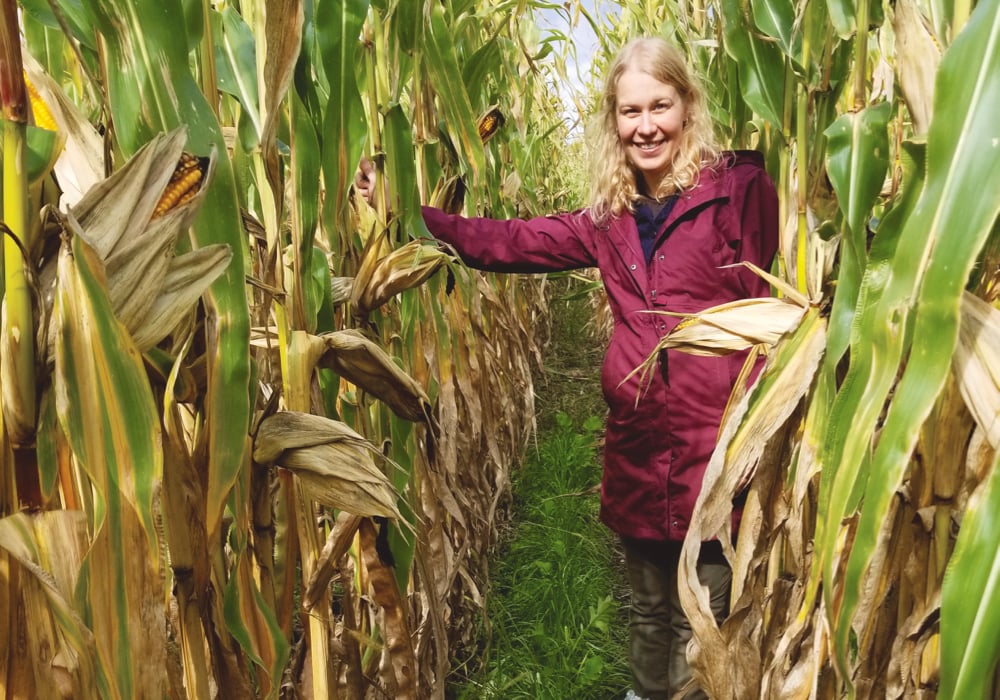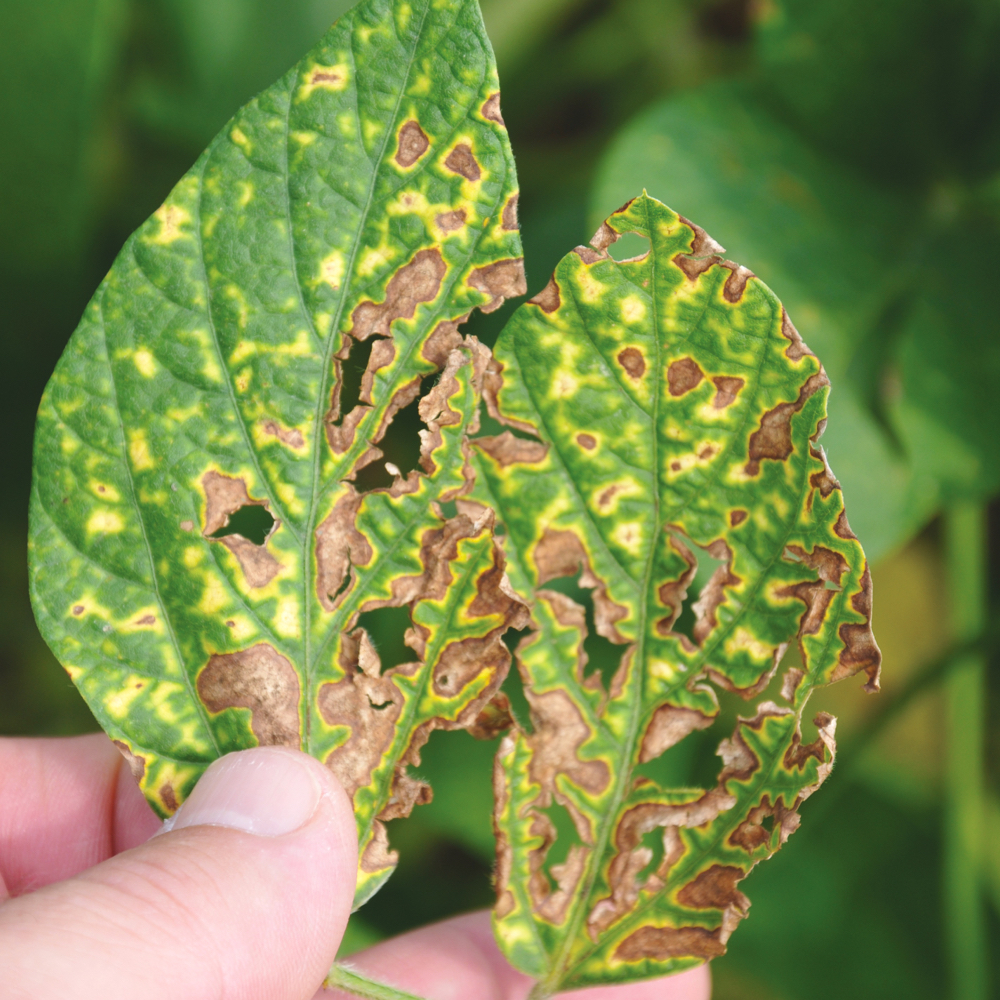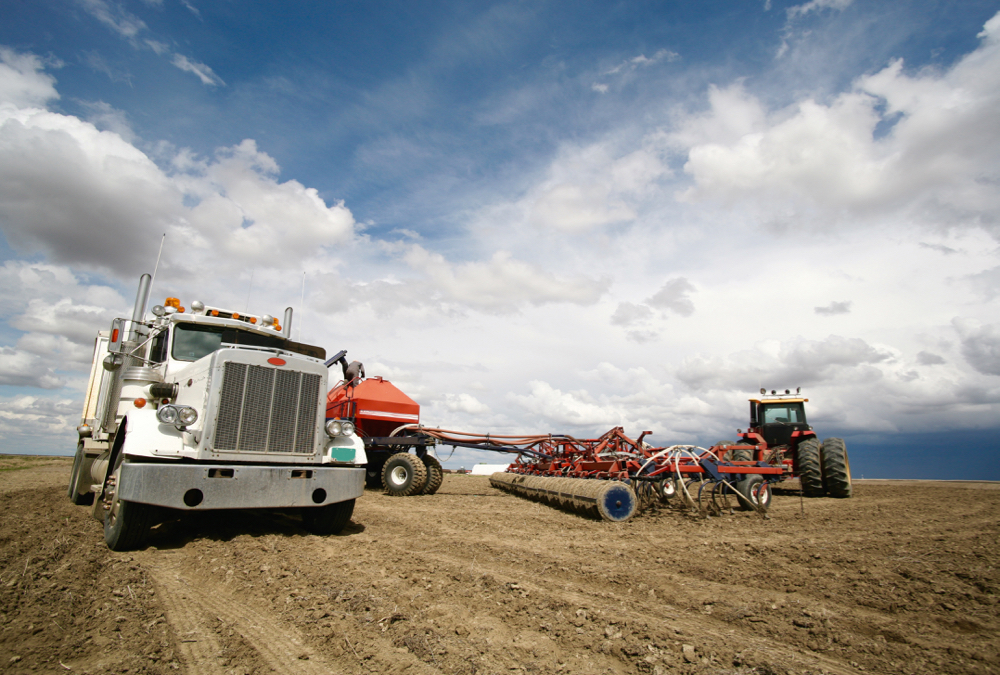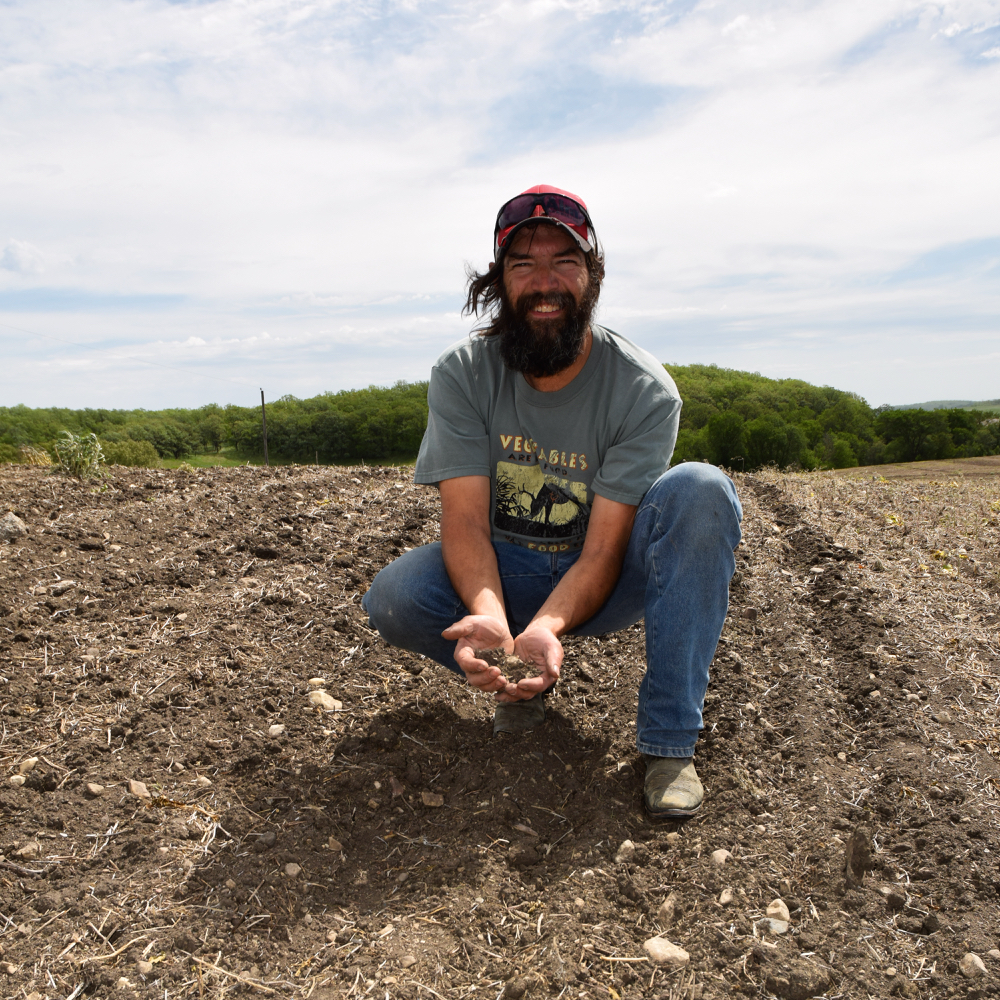In the space of a few years, soybeans on the eastern Prairies have gone from an experimental crop to a standard in the rotation, but there’s still that lingering thought that soybeans are a sensitive short-season crop and you need to get them in early to avoid fall frost. But how early? And what about frost at the beginning of the season?
Manitoba Agricultural Services Corporation (MASC) has not reviewed its seeding deadline for soybeans for at least 13 years. At present, MASC’s seeding deadline for full crop insurance on soybeans is May 30 in most areas. In Saskatchewan, the deadline is June 5.
Read Also

Sensing the soil: Root cell research finds ‘stress hormone’
Research into how root cells react to soil stressors could help plants better adapt to changes in their climate.
Previously, the general recommendation for planting soybeans in Manitoba was when soil temperature has warmed to at least 10 C, which is typically mid-May or later, but the new recommendation is to plant within two weeks of the last expected frost. Growers can also consult the “time of seeding compromise” diagram that is found on the Manitoba Pulse and Soybean Growers (MPSG) soybean production guidelines factsheet, which also includes date, soil temperature, 24-hour forecast and personal risk profiles.
There is, however, a growing trend among Manitoba farmers to seed soybeans earlier.
Over the past decade, more varieties have come to market rated as early or short season for Manitoba (maturing in under 115 days). This has hastened the spread of soybeans across the north and western parts of Manitoba and into Saskatchewan, but delayed seeding is often a risk in these areas, so growers are keen to know, if conditions are right, how early they can go?
Planting early optimizes yield
From 2014 to 2015, Yvonne Lawley of the University of Manitoba investigated soybean seeding dates across a range of soil temperatures from 6 C to 16 C at Carman, Morden and Melita. Because soil temperature fluctuates throughout the day and from day to day, the definition of soil temperature for the study was the temperature at five cm seed depth at 10 a.m. for two consecutive days.
The study concluded that soil temperature at planting likely had less effect than date on yield. Low soil temperature caused slower emergence in spring (24 to 35 days at 6 C to 12 C,and four to 16 days to emerge at 14 C to 22 C soils), so although early-season seeding affected emergence, it did not affect yield later in the season.
A second experiment at Carman, Man., and Carrington, North Dakota, looked at planting date and plant population. A sub- set of this data was combined with the soil temperature experiment to encompass a broader range of planting dates. The main finding was that soybean yield declined by 0.23 bu./ac. with each one-day delay in planting (from April 27 to June 16 at both sites). Overall findings were that the very earliest seeding dates tended to optimize yield at all sites, regardless of soil temperature, and based on this it is recommended that soybeans be planted in May, accounting for frost risk and other time-of-seeding considerations.
To further validate these findings across a wider range of environments, University of Manitoba research agronomist Kristen MacMillan continues to study soybean seeding dates. In 2017, study locations were established at Carman, Arborg and Melita using four seeding windows based on date instead of soil temperature (May 4, May 8-14, May 16-24 and May 31), with a short-season and long-season soybean variety planted at each seeding date. In 2018, a study location at Dauphin was added.
However, very early seeding does come with the risk of soybeans emerging prior to the last spring frost depending on where you are in the province. MacMillan’s work in 2017 and 2018 is expected to provide further clarity on seeding date recommendations for growers. Preliminary results from 2017 suggest that the optimum seeding window may extend from early through mid-May in Manitoba.
“Among sites in 2017, soybean yield was similar from April 28 to May 23 suggesting that farmers have flexibility in seeding soybeans,” said MacMillan. “One of the reasons this may be different from the first study is that the second week of May was previously under-represented. Seeding dates typically fell in very early May followed by mid- to late May.”
What about waiting?
MacMillan has also investigated how late soybeans can be seeded in Manitoba. From 2015 to 2017, MacMillan com- pared three varieties — very early, early and mid-season — planted in three seeding windows of late May, early June and mid-June at Arborg, Portage la Prairie and Morden. Those locations represent the current crop insurance test areas. The actual seeding dates ranged from May 24 to June 24 and data was collected on plant population, height, productivity, maturity, yield and seed quality.
The study showed that site year, seed- ing date, variety and their interactions significantly affected yield and maturity. “I’m now further investigating the relative contribution of each of those factors (and their interactions) to the measured variables to understand how management practices such as variety choice and seeding date impact yield and quality relative to environment,” says MacMillan. “For now, the more practical outcome is to convey information on yield and maturity for farmers making seeding date decisions”
In the study, MacMillan measured soybean maturity (R8) according to the number of days the variety matured before or after the normal first frost. At Portage and Morden the first frost date is September 25, and September 23 in Arborg. Varieties with below-zero numbers matured before the frost date, and those with plus numbers matured after it. Those with the plus numbers are therefore at higher risk in terms of maturity (see chart below).
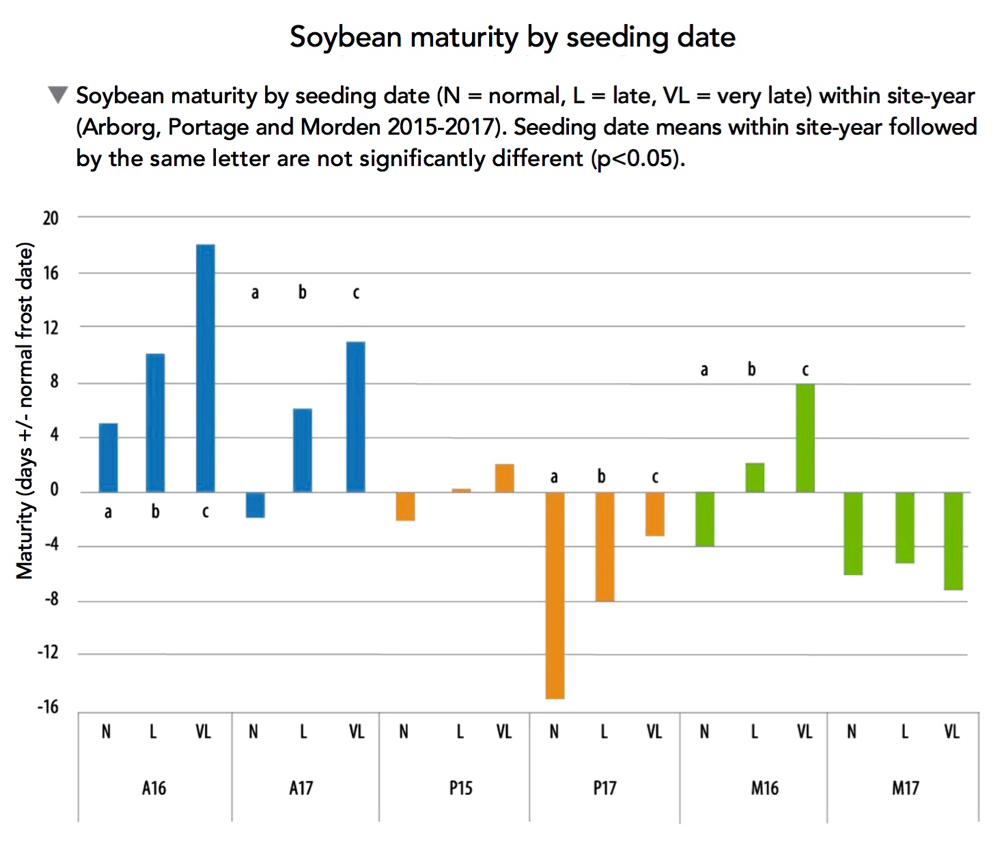
Site year had the biggest effect on maturity. During both years of the trial at the Portage site, soybeans matured within at least one day of the normal frost date regardless of seeding date. At Morden in 2017, all soybeans matured before the normal frost date, but in 2016 the late- and very-late varieties matured beyond the normal frost date because of delayed seeding at that site that year. The Arborg site showed the most risk with late-seeded soybeans, which matured five days after the normal frost date. Two varieties seeded very late at Arborg in 2017 did not mature at all. The soybean yield from the latest seeding dates (June 20 to 24) ranged between 23 to 52 bu./ac. despite maturing beyond the normal frost date.
Site year was, not surprisingly, also the biggest factor affecting yield, with growing conditions at the different sites each year causing a range in yield from 24 to 53 bu./ac. Overall, the very late seeding date (mid-June) reduced soybean yields but there is potential for seeding in early June in some regions.
The Morden and Portage sites demonstrated that there was good yield potential and little risk in seeding soybeans as late as June 9 to 12. At Arborg, soybeans seeded between May 31 and after June 6 typically had reduced yield and a higher risk of not maturing.
The interaction between variety and site year suggests that growers need to choose the appropriate variety in days to maturity when seeding late.
The results of this research project are being reviewed with Manitoba Agriculture and MASC to support a review of soy- bean seeding deadlines.
No effect on protein
Protein in soybeans grown in Manitoba is generally low, and MSPG production specialist Cassandra Tkachuk has recently been looking into soybean protein results from studies of various management factors, such as nitrogen and phosphorus fertilization and earlier seeding.
“Looking at data from past soybean field studies in Manitoba, management practices such as N and P fertilization and earlier planting have not proven to increase crude protein levels. Environment and genetics appear to be the greatest influences. However, there may be some good news stories regarding higher essential amino acid content of northern-grown soybeans, indicating livestock feed value,” says Tkachuk, who emphasizes the importance of local research for Manitoba growers. “That’s why commodity groups like MPSG are funding research focused on measures of crude protein versus amino acid content in Manitoba-grown soybeans.”
Seed on the long weekend
Meanwhile in Saskatchewan, a seeding date study from 2014 to 2016 concluded that seeding around the May long weekend resulted in highest yields compared to earlier or later seeding.
The study led by Garry Hnatowich, research director of the Irrigation Crop Diversification Corporation (ICDC) at Outlook, Sask., compared bare soybean seed and treated seed planted early to late on May 7, 14, 21, 28 and June 4 and 11.
“The reason for the initiation of the seeding date study here was that the earliest-maturing varieties that we had a couple of years ago were still 120-plus days, and for the most part our growing season is 110 days, so the concern was if farmers are considering trying to replace peas in their rotation with soybean, how early could they get it in,” says Hnatowich.
In 2016, the last year of the study, Saskatchewan had an abnormally warm May so soybeans seeded the first two weeks of May yielded well, but that wasn’t the case in the previous two years, which were closer to normal. “The bottom line is, we are looking at a May long weekend planting scenario and we’ve got a window there of that third and fourth week of May, but there was no sense planting into the first or second week of June — that’s just extending it out way too far.”
Planting before the third week of May also reduced pod numbers and increased the number of pods closer to the ground, resulting in significant harvest losses that further decreased yield.
The Saskatchewan study also established that seed treatment increased yield and helped to prevent seed rot, but these beneficial effects wore off completely after the third week of May.
Another interesting observation from this study was that with the first two planting dates — May 7 and 14 — the plants emerged only a few days ahead of those seeded around the May long weekend.
This suggests that soil temperature is still important, but the 2016 season made the point that growers shouldn’t be lulled into a false sense of security by daytime maximum temperatures.
“We had some 30-plus degree temperatures in early May, but at night it was still going down to two or three degrees,” says Hnatowich. “At that time of year, we’ve still got more dark than light. So the seeds were heating, but they were only hitting that heat of the day for a brief period of time at four or five o’clock and then they were starting to cool down again. You can’t use the maximum daytime temperature as a real indicator; you’ve got to be watching those nighttime temperatures.”
This article was originally published in the February 2019 issue of the Soybean Guide.




